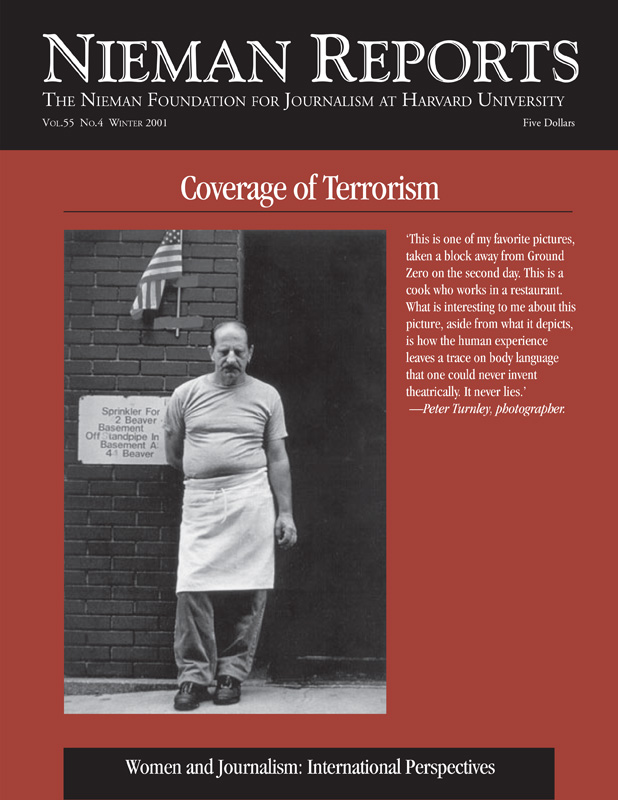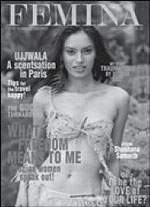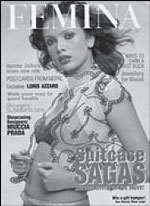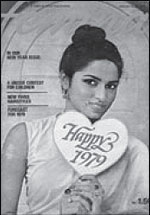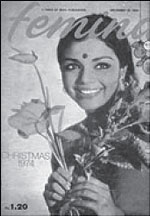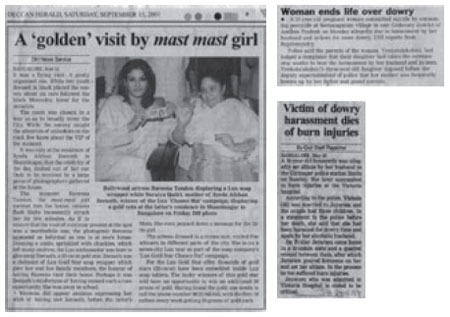
A comparison between coverage of beauty and dowry deaths.
Take one billion people, add a mind-boggling diversity of lifestyles, and what you have is a nation of paradoxes. There were, at last count, 49,145 newspapers and periodicals in over 100 languages and dialects in India, but the country also has the largest number of illiterates in the world. Indira Gandhi, a woman, was prime minister for 16 long years, yet more than 250 million Indian females remain unlettered.
To portray the changing role of women in journalism and the changing ways in which women are portrayed in the media, it is to images I turn, like someone pulling snapshots from albums to describe an evolving place and people.
In the first set of snapshots, a popular Tamil-language weekly serialized a story some 50 years ago in which the protagonist, a battered wife, decides finally to break away and takes off her “thaali” chain (the sacred marriage symbol that a bridegroom ties round the bride’s neck, never to be removed as long as he is alive). Though fictitious, the gesture brought angry waves of protests from outraged readers. She could leave her husband, but to remove the thaali? Sacrilege!
Today, a young bride in “Kora Kaagaz,” a popular family serial, enjoying a high viewership on nationwide television, yanks off the same auspicious marriage symbol and walks out of a sham marriage. And millions of viewers applaud her spunk.
In another set of snapshots, 20 years ago, I was asked to contribute a short story to Savvy, a leading women’s magazine. I wrote about a young, recently widowed woman who refuses to dress in drab white or remove her bangles (as decreed by custom) and decides to continue to dress and live the way she used to, for the sake of her young son. Brickbats flew. Some readers accused me of “destroying our glorious culture of fidelity and purity in women.” (How wearing a green, rather than a white, sari constitutes infidelity I haven’t yet understood.) Some praised it for its “boldness.”
Today, this story wouldn’t raise half an eyebrow.
And so the comparisons go on: During 1984, when I produced a radio documentary on women in Indian society, a woman reporter I interviewed commented on her fight for inclusion in riot coverage assignments. “Well, don’t come crying to me later, when you get hurt,” her male editor quipped. “Male reporters can be just as scared by bullets—they too can get hurt, right?” she argued.
Today, Barkha Dutt has won kudos for her courageous reporting from a bunker in war-torn Kashmir, with missiles whizzing past her ear.
A Sunday morning in October 2001: Every paper carries, in its supplement, a “women’s section” ranging from serious/ feminist to frothy/ frivolous. But even in the ones that carry strongly feminist columns, the matrimonial ad section is an eye opener. “Wanted, fair, tall, slim bride,” says an advertisement from the parents of a software engineer based in the United States. (There are no such specifications in the “grooms wanted” columns.)
I asked an editor if he had considered refusing such ads for “fair” brides. “You must be joking,” he retorted. The ads go out on the Internet and mean revenue. Market forces (not social ethics—much less gender equity) dictate contents, with profits the main criterion, especially when most publications are owned by businesses. A strong, high-profile woman edits the popular weekly section of the paper. I ponder this paradox and conclude that even if today most editorial supplements are edited by women, the contents of the main paper are overseen and decided by male editors, therefore changes in gender-linked perceptions of “news” are merely superficial.
There have been exceptions, such as when women in the media made a significant contribution to gender equity in regard to the law involving rape. In 1979, the Supreme Court exonerated a policeman of rape on the grounds that the victim, a teenage tribal girl, had had sexual relations with her boyfriend and was therefore of lax morals and could have consented to the policeman’s advances. Women activists, supported vigorously by women in the media, succeeded in raising a national outcry and in reopening the case. The rape law was subsequently amended to put the onus of proving innocence on the accused rather than the victim, especially in custodial rape cases.
There is today, compared with a generation ago, an overwhelming visibility of women in the media. But that does not necessarily translate into gender equity in terms of the content of what goes on the pages. What we tend to forget in this confusing scenario is that “engineer” or “doctor” does not necessarily equate with “liberal-modern,” and “unlettered” does not mean lacking in spunk. Nanjangud Tirumalamba, a pioneering woman journalist of 100 years ago, was married at 10 and widowed at 14. Forced to sit at home thereafter as an “inauspicious outcast,” this woman taught herself to write, went on to start a journal in 1917 and, through her work, became a role model for younger women. She died in 1982 at the age of 93, and a prestigious prize—competed for by women writers and journalists—is now given in her honor.
Eighty years ago, male journalists ridiculed Tirumalamba’s writings through scathing criticism. Today, women journalists complain that many male editors still regard them as suitable only for covering “soft” stories—fashion and flower shows, for example. “I wanted to do a story on the problems of women commuters on buses—seats reserved for women are often taken by men who abuse us about wanting equality,” a female reporter explained. “My story was reduced to a small item of 300 words with women’s strong comments edited out and men’s frivolous ones left in, raising a laugh. It was also relegated to an inside page, though working women make up 50 percent of bus commuters.” Another trainee journalist said, “I submitted a piece about men being taught to share kitchen and child-care duties. The editor said, ‘Why don’t you turn it into a humor piece?’”
The recent attacks on Americans took more than 3,000 lives. Many more women die every year in what are called “dowry deaths” in India. When they bring dowries considered insufficient by their in-laws, they are doused in kerosene and burned. The news of each such incident appears as a tiny, two-column-inch item tucked in an inside page. There is little media outcry, except for an occasional article written by a woman activist, and little public outrage. More women work as journalists today than ever before, yet dowry deaths continue not only to occur but to increase in number. In contrast, a four-minute visit by a movie actress on a soap brand promotion tour gets reported prominently (10 column inches), with a large color photograph and gushing descriptions of what she wore.
I pull out Femina magazines from the 1970’s and compare them with current issues. Even before looking inside, the covers make a statement: In the old issues, the covers seem soft, demure, feminine and “goody.” They show smiling women, hair tied back neatly, holding up flowers or a heart-shaped card saying, “Happy 1979.” A contest for children, hairstyles and star forecasts are the highlights.
Today the cover girls appear in skimpy, barely there western clothes, hair blown loose, mouth open, bellybutton exposed (message: “be daring!”). Designer clothes, a quiz on “Is he the love of your life?” and “You can ask him out” are the highlighted features. Liberation and empowerment have become equated—even in a women’s magazine professing to be substantive—with sauciness or “becoming more like the west” rather than addressing some of the harsh realities that affect the lives of millions of disadvantaged women.
The concerns and needs of the 240 million rural women of the country become largely irrelevant, because they don’t buy magazines. Once in a while, a gutsy rural woman does get profiled in the mainstream papers, but the norm is still to stick to fashions, fancy cuisine, and fitness regimens (to fight obesity) rather than focus attention on hunger and destitution among the teeming millions. A class/income divide operates, within gender.
Television has a wider reach. More than 87 percent of Indians have access to it, so TV could contribute effectively to women’s empowerment through innovative programs. But again, profits are determined by sponsorship, and sponsors (mostly multinationals, thanks to the new economic policy of globalization) don’t want grim tales of oppression or gender inequities because these will not sell their lipsticks or cola drinks. (“Why else would we sponsor, except for boosting sales?” says one marketing executive candidly.)
“I can’t glamorize feminist issues. If I don’t glamorize, I don’t sell. If I don’t sell, I lose my job,” an editor concedes frankly, while another adds, “It is like carrying cigarette ads: Everyone knows cigarettes kill and yet you find full page ads because they bring attractive revenues. So also with sexism.”
Women journalists break stock exchange scam stories and, at the same time, sexist depictions of the female continue to appear alongside their work. What we are experiencing in mainstream media as well as in women’s magazines is an amorphous mix of traditional and “modern” viewpoints and perspectives. And this is happening, in part, because the status of women in Indian society is itself in a state of flux, and the business priorities override the efforts and sensibilities of those who argue that the realities of women’s lives—both their achievements and their huge challenges—ought to be honestly portrayed.
Sakuntala Narasimhan is a columnist specializing in gender issues and author of 10 books. Her most recent, “Empowering Women: An Alternative Strategy From Rural India,” published by Sage in 1999, is a bestseller in India. She received the Media Foundation (Delhi) award for Outstanding Woman Journalist of the Year in 1984, the Journalist of the Year Award in 1998, and the National Award for Human Rights Journalism in 2000.
